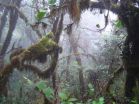(Press-News.org) A safe haven could be out of reach for 9 percent of the Western Hemisphere's mammals, and as much as 40 percent in certain regions, because the animals just won't move swiftly enough to outpace climate change.
For the past decade scientists have outlined new areas suitable for mammals likely to be displaced as climate change first makes their current habitat inhospitable, then unlivable. For the first time a new study considers whether mammals will actually be able to move to those new areas before they are overrun by climate change. Carrie Schloss, University of Washington research analyst in environmental and forest sciences, is lead author of the paper out online the week of May 14 in the Proceedings of the National Academy of Sciences.
"We underestimate the vulnerability of mammals to climate change when we look at projections of areas with suitable climate but we don't also include the ability of mammals to move, or disperse, to the new areas," Schloss said.
Indeed, more than half of the species scientists have in the past projected could expand their ranges in the face of climate change will, instead, see their ranges contract because the animals won't be able to expand into new areas fast enough, said co-author Josh Lawler, UW associate professor of environmental and forest sciences.
In particular, many of the hemisphere's species of primates – including tamarins, spider monkeys, marmosets and howler monkeys, some of which are already considered threatened or endangered – will be hard-pressed to outpace climate change, as are the group of species that includes shrews and moles. Winners of the climate change race are likely to come from carnivores like coyotes and wolves, the group that includes deer and caribou, and one that includes armadillos and anteaters.
The analysis looked at 493 mammals in the Western Hemisphere ranging from a moose that weighs 1,800 pounds to a shrew that weighs less than a dime. Only climate change was considered and not other factors that cause animals to disperse, such as competition from other species.
To determine how quickly species must move to new ranges to outpace climate change, UW researchers used previous work by Lawler that reveals areas with climates needed by each species, along with how fast climate change might occur based on 10 global climate models and a mid-high greenhouse gas emission scenario developed by the UN Intergovernmental Panel on Climate Change.
The UW researchers coupled how swiftly a species is able to disperse across the landscape with how often its members make such a move. In this case, the scientists assumed animals dispersed once a generation.
It's understandable, for example, that a mouse might not get too far because of its size. But if there are many generations born each a year, then that mouse is on the move regularly compared to a mammal that stays several years with its parents in one place before being old enough to reproduce and strike out for new territory.
Western Hemisphere primates, for example, take several years before they are sexually mature. That contributes to their low-dispersal rate and is one reason they look especially vulnerable to climate change, Schloss said. Another reason is that the territory with suitable climate is expected to shrink and so to reach the new areas animals in the tropics must generally go farther than in mountainous regions, where animals can more quickly move to a different elevation and a climate that suits them.
Those factors mean that nearly all the hemisphere's primates will experience severe reductions in their ranges, Schloss said, on average about 75 percent. At the same time species with high dispersal rates that face slower-paced climate change are expected to expand their ranges.
"Our figures are a fairly conservative – even optimistic – view of what could happen because our approach assumes that animals always go in the direction needed to avoid climate change and at the maximum rate possible for them," Lawler said.
The researchers were also conservative, he said, in taking into account human-made obstacles such as cities and crop lands that animals encounter. For the overall analysis they used a previously developed formula of "average human influence" that highlights regions where animals are likely to encounter intense human development. It doesn't take into account transit time if animals must go completely around human-dominated landscapes.
"I think it's important to point out that in the past when climates have changed – between glacial and interglacial periods when species ranges contracted and expanded – the landscape wasn't covered with agricultural fields, four-lane highways and parking lots, so species could move much more freely across the landscape," Lawler said.
"Conservation planners could help some species keep pace with climate change by focusing on connectivity – on linking together areas that could serve as pathways to new territories, particularly where animals will encounter human-land development," Schloss said. "For species unable to keep pace, reducing non-climate-related stressors could help make populations more resilient, but ultimately reducing emissions, and therefore reducing the pace of climate change, may be the only certain method to make sure species are able to keep pace with climate change."
INFORMATION:
The third co-author of the paper is Tristan Nuñez, now at University of California, Berkeley. Both Schloss and Nuñez worked with Lawler while earning their master's degrees. Lawler did this work with support from the UW School of Environmental and Forest Sciences using, in part, models he previously developed with funding from the Nature Conservancy and the Cedar Tree Foundation.
For more information:
Schloss, cell 440-666-6389, cschloss@uw.edu
Lawler, 206-685-4367, jlawler@u.washington.edu (Note: Lawler is away from the office the week of May 14 but will check for messages once or twice a day)
Nearly one-tenth of hemisphere's mammals unlikely to outrun climate change
2012-05-15
ELSE PRESS RELEASES FROM THIS DATE:
Scientists make breakthrough in bile duct cancer with discovery of new gene mutations
2012-05-15
Grand Rapids, Mich. (May 14, 2012) - A team of international scientists has made a significant breakthrough in understanding the cause of bile duct cancer, a deadly type of liver cancer. By identifying several new genes frequently mutated in bile duct cancers, researchers are paving the way for better understanding of how bile duct cancers develop. Their discovery is published online in Nature Genetics.
Bile Duct Cancer, or Cholangiocarcinoma, is a fatal cancer with a poor prognosis. Accounting for 10 to 25 per cent of all primary liver cancers worldwide, bile duct cancer ...
Great recession reflux amounts to more hunger among seniors
2012-05-15
URBANA – A new study that looked at the hunger trends over a 10-year period found that 14.85 percent of seniors in the United States, more than one in seven, face the threat of hunger. This translates into 8.3 million seniors.
"In 2005, we reported that one in nine seniors faced the threat of hunger," said Craig Gundersen, University of Illinois associate professor of agricultural and consumer economics and executive director of the National Soybean Research Laboratory who led the data analysis on the study. "So, unlike the population as a whole, food insecurity among ...
New York Stem Cell Foundation scientist grows bone from human embryonic stem cells
2012-05-15
NEW YORK, NY (May 14, 2012) -- Dr. Darja Marolt, an Investigator at The New York Stem Cell Foundation (NYSCF) Laboratory, is lead author on a study showing that human embryonic stem cells can be used to grow bone tissue grafts for use in research and potential therapeutic application. Dr. Marolt conducted this research as a post-doctoral NYSCF – Druckenmiller Fellow at Columbia University in the laboratory of Dr. Gordana Vunjak-Novakovic.
The study is the first example of using bone cell progenitors derived from human embryonic stem cells to grow compact bone tissue ...
Brain circuitry is different for women with anorexia and obesity
2012-05-15
AURORA, Colo. (May 14, 2012) - Why does one person become anorexic and another obese? A study recently published by a University of Colorado School of Medicine researcher shows that reward circuits in the brain are sensitized in anorexic women and desensitized in obese women. The findings also suggest that eating behavior is related to brain dopamine pathways involved in addictions.
Guido Frank, MD, assistant professor director of the Developmental Brain Research Program at the CU School of Medicine and his colleagues used functional magnetic resonance imaging (fMRI) ...
Growing risks from hatchery fish
2012-05-15
Portland, Oregon – May 14, 2012 -- A newly published collection of more than 20 studies by leading university scientists and government fishery researchers in Alaska, British Columbia, Washington, Oregon, California, Russia and Japan provides mounting evidence that salmon raised in man-made hatcheries can harm wild salmon through competition for food and habitat.
"The genetic effects of mixing hatchery fish with wild populations have been well-documented," says journal editor David Noakes from Oregon State University. "But until now the ecological effects were largely ...
Genetic test identifies eye cancer tumors likely to spread
2012-05-15
AUDIO:
The most common form of cancer in the eye can be deadly. New treatments have allowed doctors to preserve vision in patients with ocular melanoma, but sometimes the cancer...
Click here for more information.
Researchers at Washington University School of Medicine in St. Louis have developed a genetic test that can accurately predict whether the most common form of eye cancer will spread to other parts of the body, particularly the liver.
In 459 patients with ocular ...
Lawrence Livermore work may improve the efficiency of the biofuel production cycle
2012-05-15
By deciphering the makeup of a bacterium found in the soil of a tropical rain forest, scientists may have a better understanding of how to more efficiently produce biofuels.
The production of liquid fuels derived from plant biomass offers a promising technology for reducing greenhouse gas emissions and dependence on fossil fuels.
While sugars stored within the plant cell wall, known as lignocellulose, are plentiful enough to supply most energy needs on the planet, their extraction is difficult and requires chemical pretreatment followed by enzymatic digestion using ...
Microbe that can handle ionic liquids
2012-05-15
In the search for technology by which economically competitive biofuels can be produced from cellulosic biomass, the combination of sugar-fermenting microbes and ionic liquid solvents looks to be a winner save for one major problem: the ionic liquids used to make cellulosic biomass more digestible for microbes can also be toxic to them. A solution to this conundrum, however, may be in the offing.
Researchers with the U.S. Department of Energy (DOE)'s Joint BioEnergy Institute (JBEI), a multi-institutional partnership led by Berkeley Lab, have identified a tropical rainforest ...
Religion replenishes self-control
2012-05-15
There are many theories about why religion exists, most of them unproven. Now, in an article published in Psychological Science, a journal of the Association for Psychological Science, psychologist Kevin Rounding of Queen's University, Ontario, offers a new idea, and some preliminary evidence to back it up. The primary purpose of religious belief is to enhance the basic cognitive process of self-control, says Rounding, which in turn promotes any number of valuable social behaviors. He ran four experiments in which he primed volunteers to think about religious matters. Those ...
How to minimize stroke damage
2012-05-15
MAYWOOD, Il. -- Following a stroke, factors as varied as blood sugar, body temperature and position in bed can affect patient outcomes, Loyola University Medical Center researchers report.
In a review article in the journal MedLink Neurology, first author Murray Flaster, MD, PhD and colleagues summarize the latest research on caring for ischemic stroke patients. (Most strokes are ischemic, meaning they are caused by blood clots.)
"The period immediately following an acute ischemic stroke is a time of significant risk," the Loyola neurologists write. "Meticulous attention ...


